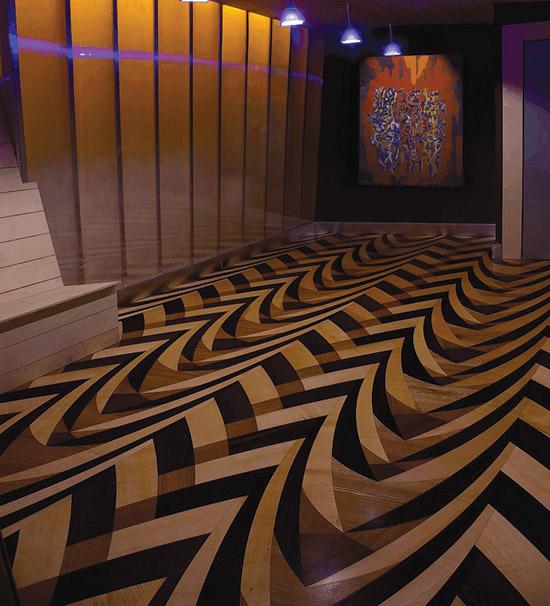Wood Cuts - June 2011
By Frank Kroupa
When most people think about wood flooring installations, they generally think about residential applications, but there is another lucrative market out there that cannot be ignored: the commercial sector.
Although commercial hardwood has experienced a decline in the past few years, it still represented a $159 million market in the United States in 2010. That translates to 10% of the total hardwood flooring purchases made in the United States that same year, according to Market Insights/Torcivia.
In general, the same criteria apply to both commercial wood flooring applications and residential applications, but because commercial wood flooring will receive significantly more traffic than residential wood flooring, there are some issues that must be considered.
Both solid wood flooring and engineered wood flooring will work well in a commercial setting. Solid wood flooring is exactly what the name implies: a solid piece of wood from top to bottom. The thickness of solid wood flooring can vary, but generally ranges from 3/4” to 5/16”. The benefit of solid wood flooring is that it can be sanded and refinished many times, but solid wood floors can be used only above grade.
However, engineered wood floors can be used either above grade or below grade. This type of wood flooring consists of three to nine plies layered at right angles to each other. The top veneer consists of high-quality wood. This configuration makes engineered wood very stable, meaning that it will contract and expand less than solid wood flooring during fluctuations in humidity and temperature.
How these floors are installed will depend on the subfloor being used. The nail down and glue down methods are the most popular for commercial installations. The glue down method can be used for both solid (only if recommended by the manufacturer) and engineered products, but a wood subfloor will be necessary to do a nail down installation. Floating floors, or click systems, which are increasingly used in residential settings, are not used very often in commercial settings.
The profile of the wood selected will be a consideration for commercial applications as well. Beveled edge floors have a slight bevel, or groove, between floorboards. This can allow small bits of dust and debris to accumulate between the floorboards, which can contribute to premature wear. Selecting a square edge floor can minimize this impact. In general, beveled edge floors are used in manufacturer finished wood flooring products, but in recent years manufacturers have minimized this issue by creating micro bevels or ease edged floors. The advantage of this type of wood flooring is that there is no sanding required, no fumes, no labor involved to apply finish, and no down time for drying of the finish. Square edge floors are more common with a site finished installation, which means that the floors are sanded and finished on the job site. Site finished wood floors allow for the greatest degree of customization, but with that benefit comes increased noise, dust and disruption. These problems can be minimized with the new dustless sanding systems being used by many wood flooring contractors, which reduce airborne dust and debris.
As with most residential wood floors, commercial wood floors most often are selected based on their color and appearance. The overwhelming trend is to select the wood flooring species to be used based on its natural color, instead of using stain to achieve a particular look. This works particularly well with commercial applications since this tends to hide wear and scratches better than wood floors using stain to achieve color.
If the installation includes a smooth finish, select grades, clear grades and first grade rustic species tend to conceal wear as well. However, growing in popularity in the commercial sector is the non-smooth finish, which can hide wear patterns even more effectively. These include hand-distressed floors that have an antiqued feel to them. This look is achieved through handscraping, wire brushing and rough sawing, all of which will camouflage minor scratches, imperfections and wear patterns.
Perhaps the most critical consideration in commercial wood flooring applications is the finish used. More than species, this will have the most impact on the durability of the floor and its ability to stand up to high traffic patterns. Surface finishes are very popular because they are durable, water-resistant, and require minimal maintenance. These include water-based finishes, which have a mild odor and are fast drying; oil-based finishes, which have a moderate odor and are slow drying; conversion varnishes, which have a strong odor and are fast drying; and moisture-cured finishes, which have a strong odor and are slow or fast drying depending on humidity levels. Wax finishes generally are not used in commercial settings since they will show spots from water and other contaminants more easily.
In most commercial applications, acrylic impregnated finishes can be recommended. This type of finish is injected directly into the wood to create a durable floor that can stand up to increased traffic. The new UV cured finishes can dry within a fifth of a second, which means multiple coats can be applied immediately. These finishes are as durable as the best job site finishes, and very easy to use.
Needless to say, the demand for wood flooring in the commercial sector is here to stay. Analysts believe that the greatest growth potential will occur in three major areas: healthcare facilities, retail shopping venues, and restaurant operations. Opportunities will abound for both new construction and remodeling, and wood flooring contractors will want to be prepared for meeting the demands of this high visibility, potentially high profit, market.
Copyright 2011 Floor Focus
